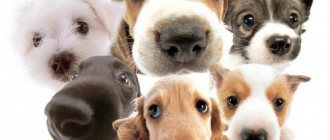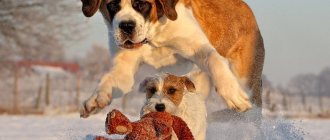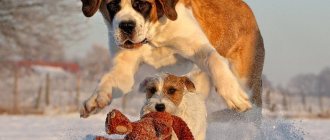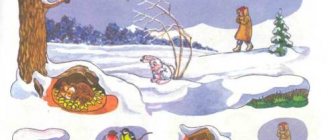"Wild and Domestic Animals"
1. Introduction to the situation.
Didactic tasks: Motivate children to engage in gaming activities.
In the morning, when children enter the group, they see animal toys (cat, dog, wolf, fox, hare, bear, cow, sheep, etc.). They ask the teacher why we have so many animals? Where are they from?
Educator: These animals were given to us, but I don’t know what to do with them. What do you think we can come up with? Children: offer to play with animals.
2. Updating knowledge.
Didactic objectives : Update children's knowledge about animals.
The game “Wild and Domestic Animals” is held
Didactic tasks: consolidating children's knowledge about animals. The ability to classify them.
Exercises are carried out with wild and domestic animals.
Didactic tasks: organize active recreation for children, develop imagination, coordination of movement.
To the music, children perform movements and show (depict) animals.
3. Difficulty in a game situation.
Didactic tasks:
- Create a motivational situation for the formation of children’s ideas about animals in their habitat;
- To form experience, under the guidance of a teacher, of fixing the difficulty and understanding its cause.
Educator: I suggest you build houses for animals. What kind of houses do you think we will build for them? Let us remember where the cat lives? Where does the cow live? Where does the fox live? Etc.
Children's answers: house, hole, kennel, forest, etc.
Educator: can we build one house for everyone?
Children's answers: No
Educator: Why?
Children's answers: wild animals live in the forest, and domestic animals live next to humans.
Educator : I suggest you divide into groups. One group will build a habitat for domestic animals, the other for wild animals.
4. «Discovery" of new knowledge.
Didactic task:
- Organizing a dialogue between a teacher and children aimed at discovering new knowledge.
- Train self-control skills, mental operations - analysis, comparison, generalization, develop logical thinking, initiative, creativity, speech.
The teacher explains to the children that everyone has their own home, their own bed, their own toys. So you and I will build a model for our animals. For pets, we will build a barn, put up a fence, and plant trees and flowers in the yard.
And for others the forest, holes, river.
Children's answers: children complete tasks with the help of a teacher.
Educator: Our layouts are ready, where do you think is best to put them?
Children: to a corner of nature.
Educator : you can come up and play with them at any time.
Artistic creativity “What to feed the animals”
Didactic tasks: develop imagination, creative abilities.
Children independently draw the products that will be fed to the animals. (cabbage, carrots, bread, water in a bucket, etc.)
5. Incorporation of new knowledge into the child’s system of knowledge and skills.
Didactic task:
- Consolidation of new knowledge in children.
- Train mental operations - analysis, comparison, analogy, develop imagination, logical thinking, speech.
Educator : oh, our animals are sick, why do you think?
Children : we fed them poorly, they caught a cold, etc.
Educator: who knows which doctor treats animals?
Reading the book “Doctor Aibolit”
Didactic task: using new knowledge together with previously acquired knowledge.
Educator: will he cure our animals?
Children's answers: no (yes)
Educator: right, of course he will cure them, give them raspberries, lemon, honey, chamomile, linden.
Theatrical performance for children “Doctor Aibolit”
Didactic task: to create conditions for the development of imagination, the ability to play a role, to bring the job started to the end.
6. Understanding.
Didactic task: to restore in children’s memory what they did during the day and create a situation of success.
What new have you learned? What did you like most?
MAGAZINE Preschooler.RF
Growing and developing together: interactive games for children 2-4 years old and their parents on the topic “Animals: domestic and wild (forest)”Dear moms and dads!
Let us together help our children grow and develop.
I bring to your attention two games on the topic “Animals: domestic and wild (forest)” for children from 2 to 4 years old.
The first game “Help the animals find their homes” will help your child remember the names of animals, remember the animal’s habitat, and teach them to classify them according to their habitat into domestic and wild (forest).
Rules of the game:
In front of you is a picture divided into two parts: a forest is drawn on the left, and a village on the right. Look carefully at this picture and name who you see in it?
(As a rule, the child will simply begin to list all the animals. Listen to him, and then summarize: they can all be called in one word - animals.)
But every animal has its own home, where it was born and raised. For some animals, the forest became such a home, and for others, the village. Some animals like to live away from people and take care of themselves, while others like to live next to people, they love when people take care of them.
And in our picture the animals got lost and confused their homes. They need help.
Where do you think a dog likes to live? Why? Let's help her and send her home. To do this, you just need to click on the dog.
It is advisable to carry out such preliminary work on each animal, as this will help you understand whether the child understands the differences between domestic animals and wild (forest) animals, and in case of difficulty, help him.
The second game “Wild Animals” consists of a series of games and will help summarize the child’s knowledge on this topic.
The game will help the child remember the names of the main inhabitants of the forest, their habitats (names of their homes), what forest animals like to eat, what their cubs are called, which of the forest inhabitants change their coat color in winter; will teach you to guess riddles about forest animals, based on their characteristic features.
The entire game is divided into five small games.
The first game is “Riddles - guesses” : you read a riddle to your child and ask him to guess it. Ask your child to explain why he thinks this riddle is about this animal. (Each riddle contains the characteristic features of the animal.)
After this, invite your child to click on the blue window with the riddle and check the correctness of his answer.
The second game is “Who eats what” : ask the child to name the pictures that are located at the very bottom - this is food for animals. Now think about which animal likes to feast on what.
What does a squirrel like to eat? Let's check. Click on the picture you named and let's check if the squirrel gets its treat.
Similar work is carried out for each animal.
The third game is “Who lives where?” : Look at the picture with your child, tell him that the houses of forest inhabitants are depicted here. Read the names of these houses to your child and ask him what he thinks which animal lives in which house.
Who lives in a hollow? Let's check: click on the house and check your answer.
The fourth game is “Whose children?” : name the pictures that are drawn below - these are baby forest animals. Let's call them together correctly again: little squirrel, little hare, little hedgehog, little bear, little fox, little wolf. Each baby has its own mother. I will name the animal’s mother for you, and you will name her baby.
The bear has - ... Let's check your answer. Click on the baby and if your answer is correct, he will run to his mother.
Similar work is carried out for each animal.
Fifth game - “Which of these animals changes their coat for the winter? What color?
All animals are preparing for winter: some, like the bear and the hedgehog, fall asleep, others' fur coats become thicker and thicker, and others generally change the color of their coats.
- Part. Look carefully at the forest animals. There is an asterisk next to each of them. You must name the animals that, in your opinion, change the color of their fur coat for the winter, and click on them with the mouse. If your answer is correct, the star will change its color to green and a happy smiley will appear, and if you are wrong, the star will turn red and a thinking smiley will appear.
- Part. You correctly found out which of the forest inhabitants changes the color of their fur coat for the winter. Now let's decide what color it will be.
Look at the colors on the right. Try to name them. If you find it difficult, I will help you.
What color does a squirrel's coat become in winter? Click on the color you named. If your answer is correct, a squirrel in a winter coat and a happy smiley will appear.
If you make a mistake, a thinking emoticon will appear.
We also work with the bunny.
Don't forget to praise your baby at the end.
You can return to these games more than once, giving your baby more independence each time.
| Next > |
Summary of GCD in the preparatory group on the topic “Wild and Domestic Animals”
Summary of GCD in the preparatory group
Author: Pyatnitskaya Svetlana Andreevna, teacher of the senior group of State Budget Educational Institution Secondary School 883, Moscow. Description of the material: I bring to your attention a summary of direct educational activities for children of the preparatory group (6-7 years old).
This material will be useful to teachers of the preparatory group (speech therapy, including). This is a summary of a complex game lesson on the formation of a holistic picture of the world, aimed at the development of verbal and logical thinking. Summary of direct educational activities for children in the preparatory group on the topic “Wild and Domestic Animals.”
Goal: To develop children’s ability to compose verbal and logical statements. Objectives: Educational: Continue to train mental operations: analysis, synthesis, comparison, generalization, abstraction. To consolidate knowledge about some distinctive features in the behavior of wild animals and their appearance. Strengthen the ability to generalize previously acquired knowledge and draw conclusions based on it. Developmental: Develop attention, observation, speed of reaction. Develop the ability to work in pairs and in a team. Develop independence, intelligence and guesswork. Speech: Enrich active and passive vocabulary: names of wild animals and adjectives: “bear”, “wolf”, “badger”, “hare”, “elk”, “boar”. Educational: To cultivate a friendly and caring attitude towards nature in general and wild (domestic) animals in particular. Demonstration material: pictures depicting wild and domestic animals (squirrels, foxes, wild boar, elk, sheep). Magnetic letters. Puzzles. Wonderful bag. Models of animals: cows, dogs, goats, rams, giraffes, horses, etc. by the number of children. Sheets with images of animal tracks: bear, wolf, wild boar, elk, hare. Handout: sheet (half) with images of animals, three of which are wild, one is domestic, or three are domestic, one is wild. Methodological techniques: introduction to a game situation, didactic games, children discovering new knowledge (working with a diagram), updating previously acquired knowledge, reproduction in a standard game, dialogue. GCD move. The teacher gathers the children around the magnetic board.
— Guys, I want to invite you to play various games today.
The first game we will play is called “Guess the Animal”. Using various objects, I encrypted the names of different animals. In order to unravel the name of the encrypted animal, you need to find out what sound the item shown in the picture begins with, find the desired letter in the cash register and attach this letter under the picture. For example: (Butterfly, Spruce, Light Bulb, Cat, Watermelon = SQUIRREL; Glasses, Vase, Heron, Watermelon = SHEEP). When the children post one word together with the teacher, he gives one encrypted word to several children, and another to several (performing the task in pairs). Then, from the pictures laid out on the table, children find images corresponding to the unraveled animal names and attach them to the board. Next, the teacher shows the children two diagrams (drawn with a black felt-tip pen on a white sheet).
Game with the “Recognize and Name” scheme. One diagram shows oak and spruce. Another diagram shows a house and a person. — What do you think these diagrams could mean?
(children's assumptions). The teacher leads the children to understand that the diagram with oak and pine symbolizes the forest, the home of wild animals, and the house and people symbolize domestic animals). - Why are they called that? (wild animals are those that live far from a person’s house - in the forest. Domestic animals are those that live near a person’s house; he feeds them, waters them, raises them, builds special houses for them: a booth, a pen, etc. ). - Let's look at the pictures on the board. What diagram should we put next to the names of these animals? (with oak and pine) - wild. What diagram should we hang on the right side? (domestic). Now I want to play the Pathfinders game with you. Children move to the carpet, sit in a circle, the teacher takes out sheets depicting animal tracks in the snow (drawn in blue gouache on a white sheet) and says:
-Winter has come.
Snow fell in the deep forest. In the snow you can see traces of the animals that live in the forest. Usually they are clearly visible near the water - the animals come to drink. -Whose tracks do you think these are? (children’s opinions, arguments: bear, because they are larger than hare, claw marks are visible). - For what reason could the bear wake up in winter (after all, he usually sleeps in a den) (children’s assumptions: he had a toothache, had a bad dream, was very thirsty). According to this principle, the teacher examines with the children wolf tracks (similar to dog tracks that children can see on the street), hare tracks (two long prints - the hind legs and two small ones - the front ones), elk tracks (these animals have sharp hooves, the tracks from which can be easily seen). see in the snow). The teacher highlights the characteristic features of the tracks and the dependence of the imprint on the snow on the structure of the animals’ paws. Next, the teacher invites the children to sit down at the tables.
Game "Fourth wheel". Animals are depicted on the cards that lie in front of the children. — Guys, look carefully at the cards that lie in front of you.
Name the animals you see (squirrel, hare, wolf, pig). Who do you think is the odd one out? (the extra one is a pig). Why? (because a pig is a domestic animal, and a wolf, a hare, a squirrel are wild animals, they live in the forest, far from humans). The teacher invites the children to stand around a table on which pictures are laid out face down.
Game "Tails". The teacher gives each child a picture of a tail (wolf, fox, hare, badger, etc.) Tails can be repeated and images of animals too. — Various animals lived in the forest.
One day, a magpie spread the news throughout the forest that tails were being distributed to animals in the clearing. Guess which tail each animal chose? Turn the pictures over and find the tail that suits you. Then the teacher asks one by one: “Who are you?” (I'm a bear). What kind of tail do you have? (I have a bear tail). Why did you decide it was a bear's tail? (it is small, short, round). Why does a bear have such a tail, what would happen if he had a tail like a fox? (thoughts, arguments of children). — We move on to the next game. You know what different animals look like, what tracks they leave in the snow, which ones are wild and which ones are domestic. And now I want to see if you can tell by touch which animals are hidden in the wonderful bag. Each of the participants tries to determine by touch and make a guess which animal is hidden in the bag. The teacher also asks other participants in the game about their guesses. For example: “I feel to the touch that this animal has horns, an udder, hooves” - “What kind of animal do you think this is?” - (cow). The child takes the animal out of the bag and shows it to everyone. The teacher asks: “What animal is this?” (at home) By analogy, the other children feel the contents of the bag. The teacher asks whether they liked the games proposed by him, thanks all the children for their active participation and ends it by summing up.
We recommend watching:
Summary of the GCD in the preparatory group on the topic “Paintings of Artists” Summary of a recreational and educational lesson on traffic rules in the preparatory group Summary of the GCD for FEMP in the preparatory group on the topic “Visiting Professor Aquarius” Synopsis of the GCD in the preparatory group on the topic “Cockerel”
Similar articles:
Summary of educational activities on cognitive and speech development in a speech therapy group preparatory to school
Summary of educational activities on cognitive and speech development for a speech therapy group preparatory to school
Summary of GCD with elements of non-traditional types of gymnastics in the preparatory group for the educational field “Physical Education”
Outline of GCD in the preparatory group
Summary of educational activities on cognitive development in the preparatory group
Quiz "Domestic and wild animals." For children 6-9 years old
- This animal is very large, approximately 2 m tall and weighing 350 kg. Its ears and tail are small. He sleeps in his den all winter, waking up only in the spring. (Bear)
- Can a penguin fly? (No)
- This pet's teeth grow throughout its life. (Rabbit)
- During birth, what animal's baby can fall from a height of 2-3 meters and not be harmed? (Giraffe)
- What is another name for a giant panda? (Bamboo Bear)
- Why do the mole's palms turn outward? (To dig the ground)
- Name the baby ram and sheep. (Lamb)
- A fox can coexist with this forest animal in the same hole. (Badger)
A visit to the zoo will be interesting for both parents and children.
Animals for children should be accessible not only in theory, but also in practice. Give your child the opportunity to see them in real form, and not in a picture. Visit a zoo or farm.
Tip: If it’s quite easy to depict the barking of a dog or the purring of a cat, then the question of how the animals of the forest or, for example, the savanna speak, may confuse you.
Even if you know how an elephant trumpets, you are unlikely to be able to imitate this sound. Then various audio recordings can come to the rescue; choose as many and varied as possible.
Every child should have an encyclopedia of animals
And children will probably be interested in learning how animals speak other languages of the world. Yes, yes, even these sounds are reproduced differently by residents of each country (even though they hear the same thing). For example, in England a pig does not grunt, but says “oink”, a Turkish dog says “hov-hov”, and an Italian rooster says “cicchirichi”.
Toy Zoo – Animal Collection






